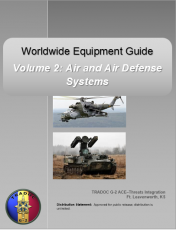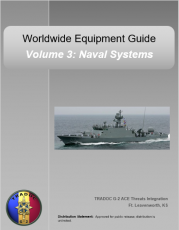Worldwide Equipment Guide
This Worldwide Equipment Guide (WEG) describes the spectrum of worldwide equipment and system trends in the Complex Operational Environment (COE). Tier Tables provide baseline examples of systems with counterparts in other capability tiers. Other systems are added to offer flexibility for tailoring the force systems mix. Substitution Tables offer other system choices versus baseline examples.
The OPFOR in the COE should also include options for portraying “hybrid threat”. Hybrid threat is defined as:
…the diverse and dynamic combination of regular forces, irregular forces, terrorist forces, and/or criminal elements, all unified to achieve mutually benefitting effects.
The OPFOR may use conventional weapons; however regular and irregular forces may also employ improvised systems, as described throughout this guide. Upgrade tables are included to capture WEG systems changes reflecting contemporary upgrade trends. Systems and technologies in Chapter 10, Countermeasures, Upgrades, and Emerging Technology, can be used in simulations for Near-Term and Mid-Term scenarios.
The pages in this WEG are designed for use in electronic form or for insertion into loose -leaf notebooks. This guide will be updated as often as necessary, in order to include additional systems, variants, and upgrades that are appropriate for OPFOR use.
We have attempted to make the information available more user friendly, easily accessible, and concise. Therefore, much of the narrative on some systems has been updated and edited. If you have questions on the presentation of information or anything else included in this guide, contact the helpdesk.
How To Use Guide
The WEG is organized by categories of equipment, in chapters. The format of the equipment pages is basically a listing of parametric data. This permits updating on a standardized basis as data becomes available. For meanings of acronyms and terms, see the Glossary. Please note that, although most terms are the same as in U.S. terminology, some reflect non-U.S. concepts and are not comparable or measurable against U.S. standards. For example, if an OPFOR armor penetration figure does not say RHA (rolled homogeneous armor) do not assume that is the standard for the figure. If there are questions, consult the Glossary, or contact us.
System names reflect intelligence community changes in naming methods. Alternative designations include the manufacturer’s name, as well as U.S./NATO designators. Note also that the WEG focuses on the complete weapon system (e.g., AT-4/5/5B antitank guided missile launcher complex or 9P148 ATGM launcher vehicle), versus a component or munition (9P135 launcher or AT-4/5 ATGM).
Many common technical notes and parameters are used in chapters 3 through 6, since the systems contained in those chapters have similar weapon and automotive technologies. Chapters 2 (Infantry Weapons), 7 (Engineer and CBRN) and 8 (Logistics), offer systems with many unique parameters and therefore may not be consistent with those in other chapters.
Units of Measure
The following example symbols and abbreviations are used in this guide:
- (°): degrees (of slope/gradient, elevation, traverse, etc.)
- GHz: gigahertz—frequency (GHz = 1 billion hertz)
- hp: horsepower (kWx1.341 = hp)
- Hz: hertz—unit of frequency
- kg: kilogram(s) (2.2 lb.)
- kg/cm2: kg per square centimeter—pressure
- km: kilometer(s)
- km/h: km per hour
- kt: knot—speed. 1 kt = 1 nautical mile (nm) per hr.
- kW: kilowatt(s) (1 kW = 1,000 watts)
- liters: liters—liquid measurement (1 gal. = 3.785 liters)
- m: meter(s)—if over 1 meter use meters; if under use mm
- m3: cubic meter(s)
- m3/hr: cubic meters per hour—earth moving capacity
- m/hr: meters per hour—operating speed (earth moving)
- MHz: megahertz—frequency (MHz = 1 million hertz)
- mach: mach + (factor) —aircraft velocity (average 1062 km/h)
- mil: milliradian, radial measure (360° = 6400 mils, 6000 Russian)
- min: minute(s)
- mm: millimeter(s)
- m/s: meters per second—velocity
- mt: metric ton(s) (mt = 1,000 kg)
- nm: nautical mile = 6076 ft (1.152 miles or 1.86 km)
- rd/min: rounds per minute—rate of fire
- RHAe: rolled homogeneous armor (equivalent)
- shp: shaft horsepower—helicopter engines (kWx1.341 = shp)
- mm: micron/micrometer—wavelength for lasers, etc.



